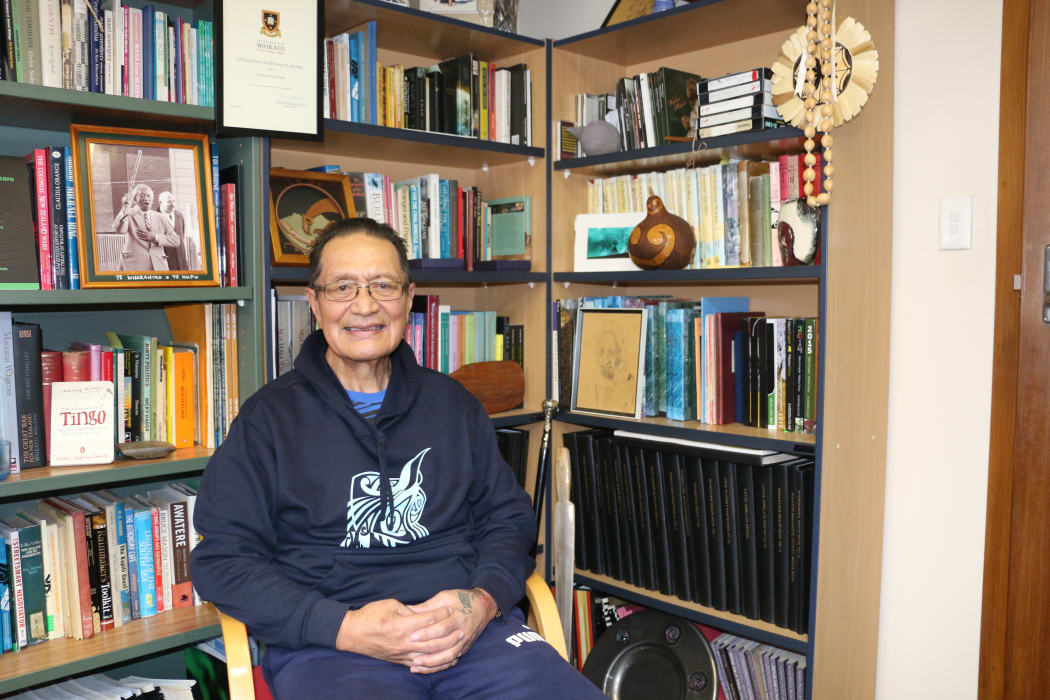
Professor Pou Temara at his office, University of Waikato Photo: RNZ/Justine Murray
In this series Te Ahi Kaa looks at the changing tide of Tikanga Māori (protocols and procedures) typically practised at marae. In the first episode of this series, Professor Temara discusses the function of marae and if it is at threat of becoming a thing of the past.
Pou Temara left Ruatahuna when he was just 15 years old to attend college in Auckland, and has not returned since.
While he knows that his heart lies in the valley and that he’ll be buried there one day amongst his people, he has no plans of moving there anytime soon. He is often asked by his people “why won’t you move back?” To which he replies no, I like my coffee and having a supermarket nearby.
Although there is jest in his response Temara knows the importance of retaining ones ‘fire’ or ‘Ahi Kaa’ to their tribal homelands and marae, and the difference is going back there often to keep those fires going.
The marae is a complex of buildings associated to iwi (tribes) and hapū (sub tribes) known as the last bastion of Māori culture, where tikanga Māori (practises and customs) are mostly carried out. But as Māori communities live further away from home, and the convenience of online engagement increases, Temara says he has noticed a shift.
“The students of today are not surprised by my view that in fifty years’ time even the marae may not have the same significance for my generation…as it will for the people of the future, marae are not that important to the bulk of the students that I teach.” he says
Pou Temara is an exponent of the Māori language and Tikanga Māori, in 2004 he was a director of the now defunct Māori School of Language excellence, Te Panekiretanga o te reo Kairangi. During its fifteen years of operation, 350 students graduated from the school.
A teacher of kapa haka and whaikōrero Temara was recognised for his contribution to Māori arts in 2012 at Creative New Zealand AW, Te Waka Toi awards, a year later in 2013 he received an honorary doctorate from Te Whare Wananga o Awanuiarangi.
In 2016 he was made a companion of the NZ order of Merit for services to Māori.
In 2004 Te Panekiretanga o te reo Kairangi - (The Institute of Excellence in the Māori language) was the brainchild of Professor Pou Temara, Sir Timoti Karetu and the late Te Wharehuia Milroy. The main purpose of the exclusive group was to nurture the student’s language fluency. But while the calibre of students were well versed in te reo Māori and that of their connection to their marae, Temara noticed a change over time.
“The whole purpose of Te Panekiretanga was to make [the students] language far better, to take it to the lofty heights…but we noticed something…so I started to ask the questions how many of you live on your marae? If we take a figure 40 students…five students put their hand up. The next question is how often do you go back to your marae?” and for those of you who went back to the marae what were the occasions, did you go back to tangihanga?” he says
From this exchange, students discussed that even though they did attend tangihanga (funeral), it was mostly at marae in Auckland and not from their hometowns, and some of his some of his students attended tangihanga at homes, which is becoming more seen as people choose their homes instead of marae to hold their tangihanga (funerals), the reasons of this may include the disconnection families have to their marae, the logistics and the costs associated to the marae hirage.
“The marae was an essential part of that community from the 1950’s and the 1960’s where people who we looked up to, whose word was mana, who made it essential for us to maintain to carry on their wishes, so marae was very important, its still is important, it’s the last bastion of tikanga Māori, where we control much of what we do.” he says

